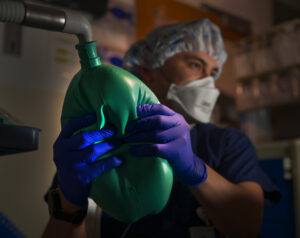Program Structure and Rotations
Categorical Training – Clinical Base Year (CBY)
The University of Washington offers 26 categorical anesthesia residency positions. The categorical positions (Clinical Base Year) are a popular choice as they allow residents to remain in the same program for all 4 years of their training and to take advantage of excellent training opportunities. We have developed a well-balanced internship year providing outstanding experience in general internal medicine, critical care, emergency medicine, pediatrics, pain medicine, pre-operative evaluation, and otolaryngology.
The categorical year rotations are linked to internal medicine and surgery programs at the UW and are in compliance with the RRC requirements for the anesthesiology clinical base year. Residents spend time in critical care rotations (MICU/SICU), emergency medicine (EM), hospital medicine (Med), cardiology (Cards), otolaryngology (ENT), pediatrics (Peds), and neurosurgery (NCCS). Residents also complete a 4-week rotation in anesthesiology (OR) and one month of jeopardy (J-POC) which has a focus on developing POCUS skills — twice-weekly residents work with faculty at the bedside or in our simulation center: WISH.
The clinical base year (CBY) includes at least 6 months of experience in caring for inpatients in internal medicine, pediatrics, surgery, or any of the surgical specialties, neurology, family medicine, or any combination of these. In addition, there are rotations in critical care and emergency medicine of at least one-month duration and no more than 2 months each.
CBY Example Schedule:

Clinical Anesthesia (CA) Years 1 – 3
Residents enter the CA 1 training after successfully completing a clinical base year.
CA 1 Year

During the first year of training, anesthesia residents rotate through the general operating room rotations at the three major hospitals, University of Washington Medical Center Montlake (UW), Harborview Medical Center (HMC), and Veterans’ Affairs Puget Sound Health Care System (VA). Residents acquire a broad spectrum of experience at the three hospitals.
In addition to the OR rotations, residents also rotate through 2 months of acute and chronic pain rotations and one month in the ICUs. Critical care training is provided in large part by anesthesiology-based faculty who are certified in both anesthesiology and critical care medicine.
During the CA1 year, all residents undertake a 2-week rotation in the post-anesthesia care unit (PACU) where they learn how to care for patients in the immediate post-operative period. During this rotation residents also participate in the continuous quality improvement process, learning about systems issues and how to recognize and manage the complications related to anesthesia.
CA1 Example Schedule:

CA 2 Year: SUBSPECIALTY ROTATIONS
During the CA2 year and for some residents starting in the end of their CA1 year, residents participate in their subspecialty rotations. These include
- 2 months of general ORs
- 2 months of critical care
- 2 months of obstetric anesthesia
- 3 months pediatric anesthesia
- 1 month of cardiac anesthesia
- 1 month of neuro anesthesia
- 1 month of regional anesthesia
CA2 Example Schedule:

CA 3 Year: ADVANCED ANESTHESIA TRAINING

In the third year, the residency training is more flexible, allowing each resident a certain amount of tailoring so their rotations reflect their own interests.
All residents are required to take rotations in pediatric anesthesia, neuro anesthesia, cardiac anesthesia, and a senior ICU month. The residents may then select their remaining months of training from the following list of specialty rotations.
- Advanced anesthesia at UWMC or HMC
- Ambulatory anesthesia
- Cardiac anesthesia
- Chronic pain
- Private practice at local Seattle hospitals
- Operating room management
- Regional and private practice experience at Virginia Mason Hospital
- Regional anesthesia
- Trauma anesthesia at HMC
- Vascular anesthesia
Elective month
- All final year residents have the opportunity to undertake an elective month. Within reason, residents may pursue any activity of interest. Examples of popular elective months include
- 1 month of TEE training with the UW cardiac anesthesiology group
- 1 month of POCUS training with the UW cardiac anesthesiology group
- 1 month of obstetric anesthesia at Evergreen private hospital
- Elective months at a variety of hospitals both locally and out of state in regional anesthesia
- Overseas experience in both developed and developing countries
- Research projects, preparing case reports and presentations for local and national conferences
CA3 Example Schedule:
